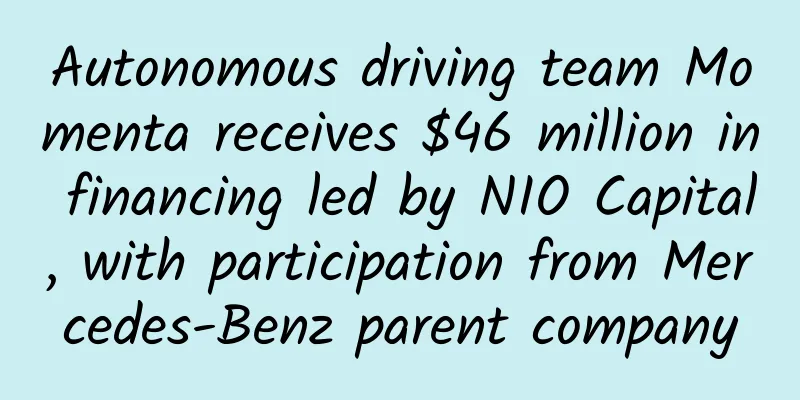Autonomous driving team Momenta receives $46 million in financing led by NIO Capital, with participation from Mercedes-Benz parent company

|
On July 25, autonomous driving startup Momenta announced today that it had received a $46 million investment in its Series B round. This round of financing was led by Weilai Capital, followed by Daimler Group (parent company of Mercedes-Benz), Shunwei Capital, Sinovation Ventures and Jiuhe Ventures. In November 2016, Momenta received a $5 million Series A financing led by Blue Lake Capital, followed by Sinovation Ventures and ZhenFund. In early 2017, it received a Series A1 financing led by Shunwei Capital. It is understood that Momenta was founded in September 2016 and is committed to building an autonomous driving brain. The core technologies include environmental perception based on deep learning, high-precision maps, and driving decisions. According to public information, the Momenta team comes from Tsinghua University, MIT, Microsoft Research Asia, etc. In the object recognition project of ImageNet 2017, which was just announced on July 18, the Momenta team also won the championship. Momenta CEO Cao Xudong said: "The financing will be used in three aspects: 1. Strengthening the core capabilities of artificial intelligence, including big data, big computing and excellent AI talents; 2. Productizing vision-based environmental perception and high-precision map technology; 3. Developing L4 driverless technology for high-frequency and rigid demand scenarios." Momenta's current products mainly consist of two parts. The first part is to create SAE autonomous driving system solutions at all levels, which is similar to the positioning of most autonomous driving teams. The second business is the feature of Momenta, which is the derived big data products and services, including high-precision crowdsourcing maps. By detecting pedestrians and identifying human feature points, it is possible to understand pedestrian postures and behavioral intentions, and it can also accurately estimate the distance between pedestrians and cars. Their route is to reconstruct the 3D position of roads, traffic signs, signals and surrounding environments by extracting semantic points from 2D images taken from multiple cars, and integrating data from GPS and IMU to create higher-precision maps. This solution is more scalable and commercially feasible because its cost is only 1/10 to 1/100 of the LIDAR data collection solution. Another benefit of crowdsourcing is that through crowdsourcing road testing, a large number of driving trajectories in high-precision semantic maps can be obtained. By learning from a large number of driving trajectories, the algorithm can make driving decision plans based on the current environmental perception and high-precision map information. Therefore, data rather than rules can be used to solve the problem of algorithm failure in rare road conditions. "To truly commercialize autonomous driving technology, it is necessary to achieve a safety level 10 times that of human drivers. Our goal is to systematically discover and solve individual cases that cannot be solved by current technology through crowdsourcing testing of 100 billion kilometers of data, and continuously improve the safety of autonomous driving algorithms." said Cao Xudong, CEO of Momenta. Of course, there have been many attempts to solve the pain points of high-precision map collection costs and low efficiency through crowdsourcing. In addition to start-ups, the well-known vision company Mobileye has its own MEM platform, and the automotive parts giant Bosch has also launched its own "Bosch Road Signature" in conjunction with Baidu, AutoNavi and NavInfo. Compared with start-up teams, these giants have existing product installation levels and relatively complete qualifications in the field of surveying and mapping, which means that start-up teams like Momenta still have some tough battles to fight on the high-precision map crowdsourcing route. As a winner of Toutiao's Qingyun Plan and Baijiahao's Bai+ Plan, the 2019 Baidu Digital Author of the Year, the Baijiahao's Most Popular Author in the Technology Field, the 2019 Sogou Technology and Culture Author, and the 2021 Baijiahao Quarterly Influential Creator, he has won many awards, including the 2013 Sohu Best Industry Media Person, the 2015 China New Media Entrepreneurship Competition Beijing Third Place, the 2015 Guangmang Experience Award, the 2015 China New Media Entrepreneurship Competition Finals Third Place, and the 2018 Baidu Dynamic Annual Powerful Celebrity. |
<<: LG is being criticized for withdrawing from China. What is the problem?
Recommend
A large CR-V for just over 300,000 yuan? The Acura RDX is not what you think
Some people say that the Acura CDX is a larger Bi...
Hyundai recalls 80,000 electric vehicles, battery supplier LG bears 70% of the cost, good news for CATL
Electric vehicle spontaneous combustion is a big ...
Case Analysis | Alipay Huabei’s Marketing Tactics on Double 11 and Double 12
How does Huabei use various content marketing for...
Information flow advertising | Double 11 is coming, take the 12 sets of e-commerce materials with the best conversion for free!
Double 11 is coming, and it’s time to spend money...
User growth and basic process!
However, today's article wants to do one thin...
How do you evaluate Jiang Xiaobai’s marketing style?
The heart-wrenching copywriting creativity only s...
JD Power: 2022 China New Energy Vehicle Customer Experience Value Research
Recently, JD Power released the 2022 China New En...
How likely is it that Tesla's fully autonomous driving will be available in 2020?
With the mass production of the Shanghai Super Fa...
Graphite: A dark appearance hides a soft heart
The English name of graphite, "Graphite"...
“Dig, dig, dig” to find the little-known facts hidden behind the lyrics!
"Dig and dig in the little garden, plant lit...
What are the shortcomings of Chinese home appliances when competing with foreign oligarchs?
Over the past 30 years, when Chinese companies ha...
How to crack the growth code of products?
How to understand growth? I believe that the core...
New energy vehicle route: waver or stick to it?
my country's pure electric vehicles are in a ...
BYD launches the "DiLink system" that can play PUBG, and enters the smart car market
Currently, the automotive industry is in a period...
How can something the size of a fist "support" an entire life?
Author: Chen Bingwei, deputy chief physician, Tia...

![Zhengda Anatomy [Daily explanation of muscle pain in the whole body]](/upload/images/67cbfebd7047f.webp)







